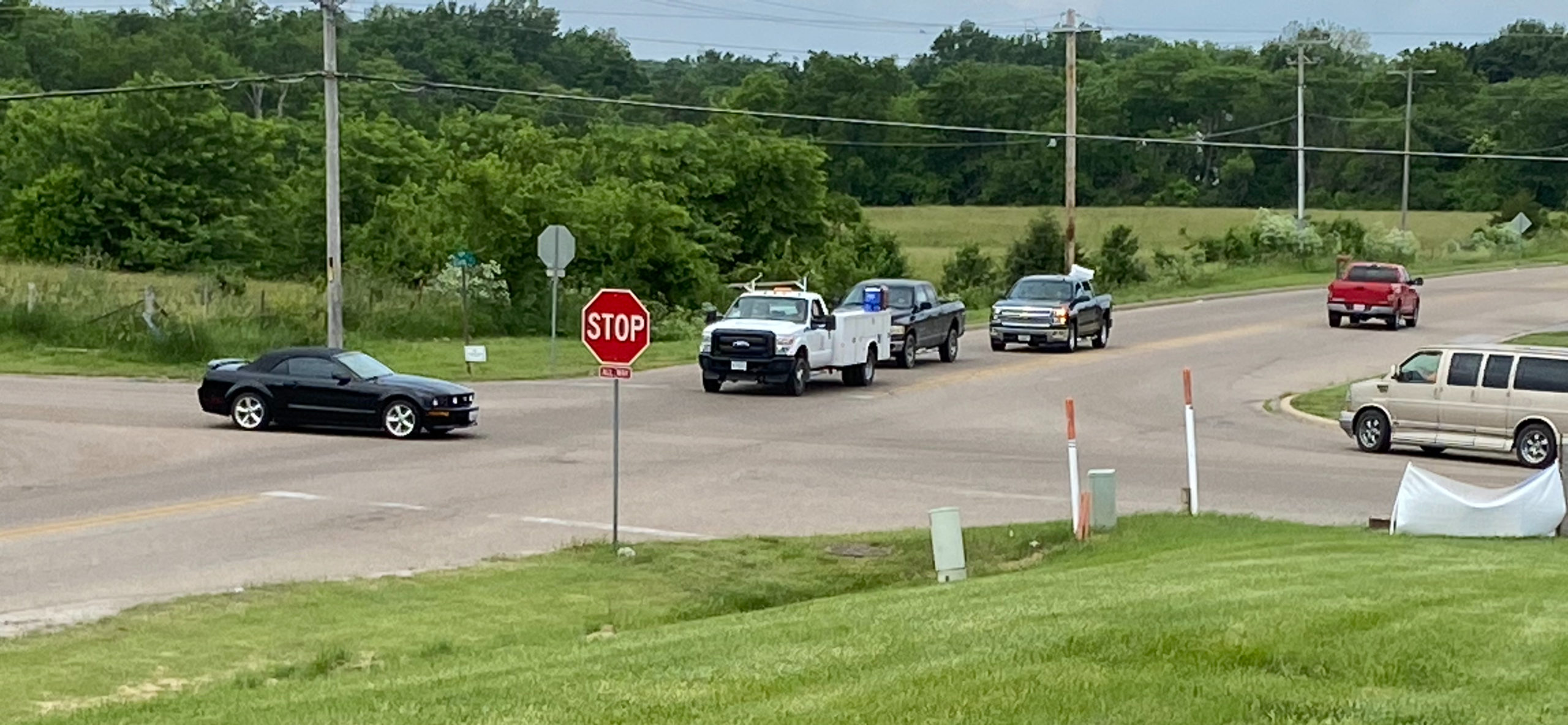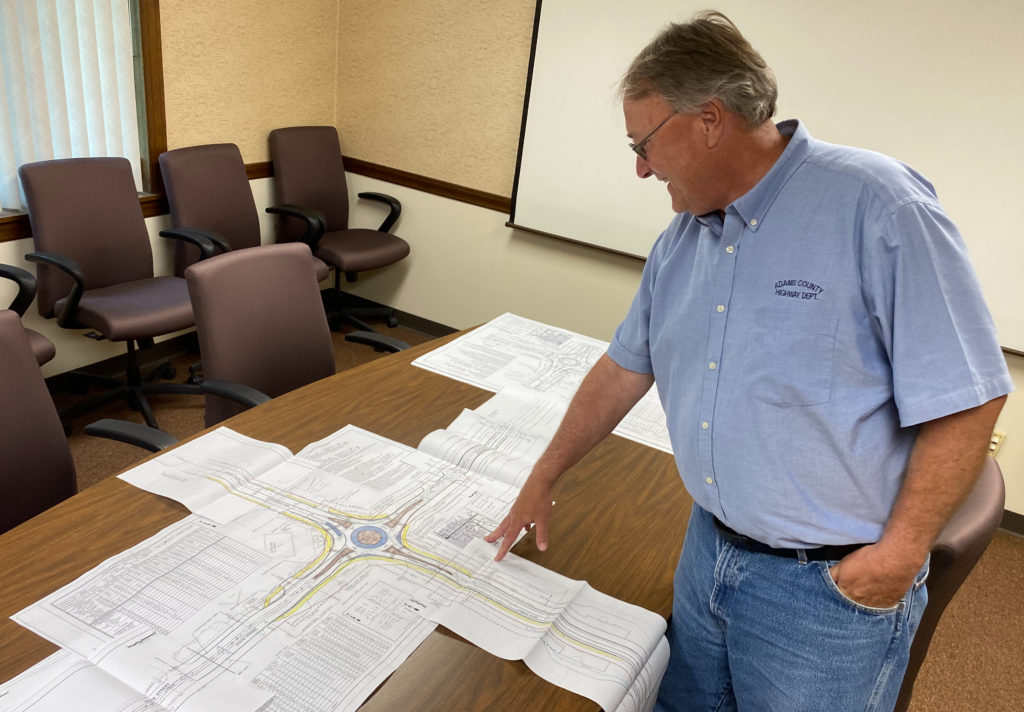Plans for 48th and State roundabout coming into focus; work expected to begin on site within year

QUINCY — Work on the creation of a roundabout in the intersection of 48th and State should begin in the late spring or early summer of next year.
Jim Frankenhoff, engineer for the Adams County Highway Department, and Steve Bange, senior project engineer for the City of Quincy, met last week with representatives from Springfield engineering firm Crawford, Murphy & Tilly. They discussed changes, improvements and adjustments to the roundabout plan.
“We went through everything, from front to back. (Crawford, Murphy & Tilly) will take that information, incorporate all of our changes and recommendations and eventually get to the preliminary submittal level for plans in the next two or three months,” Frankenhoff said.
After that step, discussion will begin with landowners about land acquisition. The Illinois Department of Transportation will receive preliminary plans for review. Frankenhoff believes a completed set of plans could be in place by the end of 2021.
The intersection at 48th and State is now a four-way stop with signs (and no lights). The plan for a roundabout at the intersection was one of several proposed projects in a regional transportation plan adopted in September 2020 by the Quincy City Council.
A study of the intersection was completed in 2014 when the proposal was introduced but eventually put on the back burner. A new study was commissioned in 2019 in the wake of more development in the area — the construction of Denman Elementary School at 42nd and Harrison and an orthopedic facility by Blessing Hospital at 48th and Maine, along with continued construction of new homes.
“We have to find a way to move people safely and efficiently through that intersection at various times of the day,” said Mike Elbe, president of John Wood Community College at 48th and Harrison. “It’s a safety concern. Traffic (headed north on 48th Street) often gets backed up to the top of the hill. We’ve had accidents where cars coming to the top of the hill are rear-ending the vehicle in front of them.
“Now, with an elementary school out in our neighborhood, we need to ensure the highest level of safety to transport people and children to school and get our students safely to our campus. When you see the number of construction projects for new homes in the southeast part of our community, there will be ever-growing traffic that needs to move through this area.”
An Insurance Institute for Highway Safety study showed roundabouts are significantly safer than a traditional stop sign or traffic signal intersection. The study found reductions of 72 to 80 percent in injury crashes and 35-47 percent in any kind of crash.
Roundabouts typically are safer because of:
- Low travel speeds. Traffic will naturally move slower through a roundabout than it will through a standard intersection. Getting into an accident is less likely when you’re driving at a lower speed.
- No traffic light to beat. There is always the chance with a traffic light that drivers will try to “beat the light.” It isn’t an issue with a roundabout.
- One-way traffic. Traffic moves in only one direction in a roundabout, virtually eliminating the chance for head-on and T-bone crashes.
Some states and cities have been slow to build roundabouts, which are gaining popularity in the United States. A 2019 IIHS study showed the safety of roundabouts improves over time as drivers become more familiar with them.

“(Roundabouts) handle just as much traffic as before in a much safer manner. There are no left-hand turn conflicts. At a signalized intersection, there are essentially 32 points of potential conflict where crashes can occur. With a roundabout, you reduce that down to eight.”
— Jim Frankenhoff, engineer for the Adams County Highway Department, as he shows plans for the roundabout at 48th and State
“(Roundabouts) handle just as much traffic as before in a much safer manner,” Frankenhoff said. “There are no left-hand turn conflicts. At a signalized intersection, there are essentially 32 points of potential conflict where crashes can occur. With a roundabout, you reduce that down to eight.”
The roundabout plan, along with the addition of turn lanes and bike paths in all directions, created plenty of public displeasure when it was discussed during the summer of 2014.
“I completely understand and respect the concerns some people have about roundabouts,” Elbe said. “However, I’ve seen them work and work well. Communities like Hannibal, Bowling Green and Troy (in Missouri) have roundabouts. I’m confident that this community can embrace a roundabout to move traffic more efficiently and more safely through this area of our community.”
Frankenhoff kept all of the emails and correspondence from the roundabout debate in 2014.
“We’ve had a lot of development. People wanted sidewalks. People wanted bike lanes. People wanted safe travel and everything else,” he said. “How is this plan different from what was done in 2014? What’s basically eliminated is anything new going north on 48th. We’re trying to build that corridor all the way (south) to Harrison.
“Roundabouts do what they are supposed to do. You just have to get used to navigating them.”
Requests for proposals must be submitted when the time nears for the first spade of dirt to be overturned. Both Frankenhoff and Bange say money is committed for this project, which is expected to cost about $2 million. How that cost will be split between the city and county is to be determined, but Bange said, “It’ll probably be a 50/50 split.”
“Once we get those bids, then it’s up to the City Council and County Board to approve both, since it’s a joint project,” Bange said.
Miss Clipping Out Stories to Save for Later?
Click the Purchase Story button below to order a print of this story. We will print it for you on matte photo paper to keep forever.

